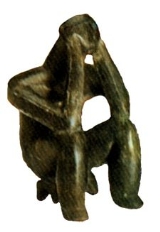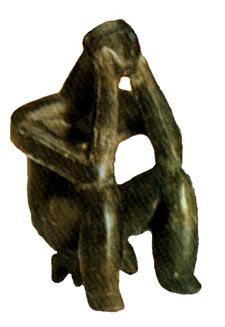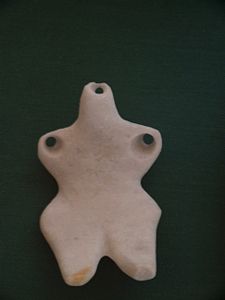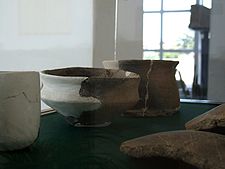
Hamangia culture
Encyclopedia



Neolithic
The Neolithic Age, Era, or Period, or New Stone Age, was a period in the development of human technology, beginning about 9500 BC in some parts of the Middle East, and later in other parts of the world. It is traditionally considered as the last part of the Stone Age...
archaeological culture
Archaeological culture
An archaeological culture is a recurring assemblage of artifacts from a specific time and place, which are thought to constitute the material culture remains of a particular past human society. The connection between the artifacts is based on archaeologists' understanding and interpretation and...
of Dobruja
Dobruja
Dobruja is a historical region shared by Bulgaria and Romania, located between the lower Danube river and the Black Sea, including the Danube Delta, Romanian coast and the northernmost part of the Bulgarian coast...
(Romania
Romania
Romania is a country located at the crossroads of Central and Southeastern Europe, on the Lower Danube, within and outside the Carpathian arch, bordering on the Black Sea...
and Bulgaria
Bulgaria
Bulgaria , officially the Republic of Bulgaria , is a parliamentary democracy within a unitary constitutional republic in Southeast Europe. The country borders Romania to the north, Serbia and Macedonia to the west, Greece and Turkey to the south, as well as the Black Sea to the east...
) between the Danube
Danube
The Danube is a river in the Central Europe and the Europe's second longest river after the Volga. It is classified as an international waterway....
and the Black Sea
Black Sea
The Black Sea is bounded by Europe, Anatolia and the Caucasus and is ultimately connected to the Atlantic Ocean via the Mediterranean and the Aegean seas and various straits. The Bosphorus strait connects it to the Sea of Marmara, and the strait of the Dardanelles connects that sea to the Aegean...
and Muntenia
Muntenia
Muntenia is a historical province of Romania, usually considered Wallachia-proper . It is situated between the Danube , the Carpathian Mountains and Moldavia , and the Olt River to the west...
and in the south. It is named after the site of Baia-Hamangia, discovered in 1952 along Lake Golovita.
Genesis and successor
The Hamangia culture began around 5250/5200 BC and lasted until around 4550/4500 BC. It was absorbed by the expanding Boian culture in its transition towards the Gumelnitsa.Its cultural links with Anatolia
Anatolia
Anatolia is a geographic and historical term denoting the westernmost protrusion of Asia, comprising the majority of the Republic of Turkey...
suggest that it was the result of a settlement by people from Anatolia, unlike the neighbouring cultures, which appear descended from earlier Neolithic settlement.
Pottery
Painted vessels with complex geometrical patterns based on spiral-motifs are typical. The shapes include pots and wide bowls.Figurines
Pottery figurines are normally extremely stylized and show standing naked faceless women with emphasized breasts and buttocks. Two figurines known as “The Thinker” and “The Sitting woman” (see photos) are considered masterpieces of Neolithic art.Settlements
Settlements consist of rectangular houses with one or two rooms, built of wattle and daub, sometimes with stone foundations (DurankulakDurankulak
Durankulak is a village in northeastern Bulgaria, part of Shabla Municipality, Dobrich Province. Located in the historical region of Southern Dobruja, Durankulak is the north-easternmost inhabited place in Bulgaria and the northernmost village of the Bulgarian Black Sea Coast, although the village...
). They are normally arranged on a rectangular grid and may form small tells. Settlements are located along the coast, at the coast of lakes, on the lower and middle river-terraces, sometimes in caves.
Inhumation
Crouched or extended inhumation in cemeteries. Grave-gifts tend to be without pottery in Hamangia I. Grave-gifts include flint, worked shells, bone tools and shell-ornaments.Important sites
- CernavodăCernavodaCernavodă is a town in Constanţa County, Dobrogea, Romania with a population of 20,514.The town's name is derived from the Slavic černa voda , meaning "black water". This name is regarded by some scholars as a calque of the earlier Thracian name Axíopa, from IE *n.ksei "dark" and upā "water"...
, the necropolisNecropolisA necropolis is a large cemetery or burial ground, usually including structural tombs. The word comes from the Greek νεκρόπολις - nekropolis, literally meaning "city of the dead"...
where the famous statues “The Thinker” and “The Sitting Woman” were discovered - the eponymous site of Baia-Hamangia, discovered in 1953 along Lake Goloviţa, close to the Black Sea coast, in the Romanian province of DobrogeaNorthern DobrujaNorthern Dobruja is the part of Dobruja within the borders of Romania. It lies between the lower Danube river and the Black Sea, bordered in south by Bulgarian Southern Dobruja.-Geography:...
.
See also
- Prehistoric Romania
- Prehistoric artPrehistoric artIn the history of art, prehistoric art is all art produced in preliterate, prehistorical cultures beginning somewhere in very late geological history, and generally continuing until that culture either develops writing or other methods of record-keeping, or it makes significant contact with another...

